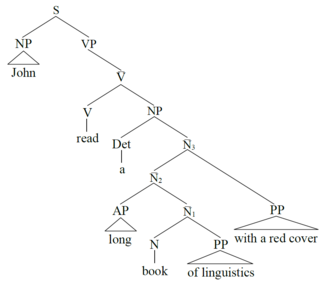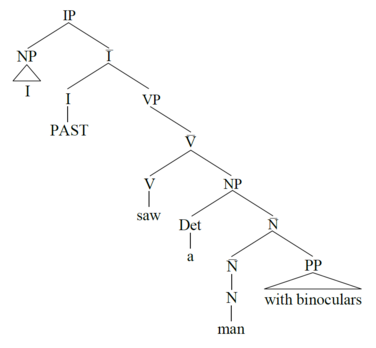X-bar theory
| Part of a series on |
| Linguistics |
|---|
|
|
In
X-bar theory was incorporated into both transformational and nontransformational theories of syntax, including
Background
The X-bar theory was developed to resolve the issues that
The PSR approach has the following four main issues.
- It assumes
- While the sentence John talked to the man, for example, involves the PSR of a Universal Grammar. This poses serious issues from the perspectives of the Plato's problem and the poverty of the stimulus.[10]
- It wrongly rules in structures that are impossible in
- It fails to capture sentence ambiguities because it assumes flat, nonhierarchical structures.[12]
The X-bar theory is a theory that attempts to resolve these issues by assuming the mold or template phrasal structure of "XP".
X-bar schema
Basic principles
The "X" in the X-bar theory is equivalent to a
The X-bar theory assumes that all
This structure is called the X-bar schema.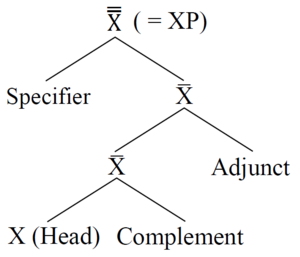
As in Figure 1, the phrasal category XP is notated by an X with a double overbar.[FN 4] For typewriting reasons, the bar symbol is often substituted by the prime ('), as in X'.
The X-bar theory embodies two central principles.
- Headedness principle: Every phrase has a head.[14]
- Binarity principle: Every node branches into two different nodes.[14]
The headedness principle resolves the issues 1 and 3 above simultaneously. The binarity principle is important to projection and ambiguity, which will be explained below.
The X-bar schema consists of a head and its circumstantial components, in accordance with the headedness principle.[4][5][6][13] The relevant components are as follows:
- Specifier: [obligatory] The node that is in a sister relation with an X' node.[15] This is a term that refers to the syntactic position itself.
- Head: [obligatory] The core of a phrase, into which a lexeme fits. The head determines the form and characteristics of the phrase as a whole.[16]
- Complement: [obligatory] An argument required by the head.
- Adjunct: [optional] A modifier for the phrase constituted by the head.
The specifier, head, and complement are obligatory; hence, a phrasal category XP must contain one specifier, one head, and one complement. On the other hand, the adjunct is optional; hence, a phrasal category contains zero or more adjuncts. Accordingly, when a phrasal category XP does not have an adjunct, it forms the structure in Figure 2.
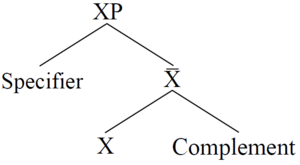
For example, the NP linguistics in the sentence John studies linguistics has the structure in Figure 3.
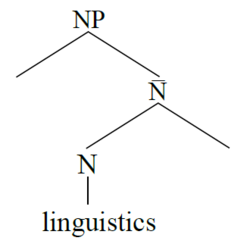
It is important that even if there are no candidates that can fit into the specifier and complement positions, these positions are syntactically present, and thus they are merely empty and unoccupied. (This is a natural consequence of the binarity principle.) This means that all phrasal categories have fundamentally uniform structures under the X-bar schema, which makes it unnecessary to assume that different phrases have different structures, unlike when one adopts the PSR.[13] (This resolves the second issue above.) In the meanwhile, one needs to be wary of when such empty positions are representationally omitted as in Figure 4.
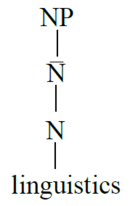
In illustrating syntactic structures this way, at least one X'-level node is present in any circumstance because the complement is obligatory.[11][17]
Next, the X'' and X' inherit the characteristics of the head X. This trait inheritance is referred to as projection.[18]

Figure 5 suggests that syntactic structures are derived in a bottom-up fashion under the X-bar theory. More specifically, the structures are derived via the following processes.
- A lexeme is fitted into the head. Heads are sometimes called zero-level projections because they are X-zero-bar-level categories, notated as X0.[19]
- The head and the complement are combined to form an X-single-bar (X, X') node, which constitutes a semi-phrasal category (a syntactic category not as big as a phrase). This category is called intermediate projection.[11]
- (An adjunct, if there is any, combines with an X' to form another X'. If there is more than one adjunct, this process is repeated.)
- An intermediate projection combines with the specifier, forming a complete phrasal category XP (X-double-bar). This category is called maximal projection.[11]
It is important that all the processes except for the third are obligatory. This means that one phrasal category necessarily includes X0, X, and XP (=X''). Moreover, nodes bigger than X0 (thus, X and XP nodes) are called constituents.[20]
Directionality of branching
Figures 1–5 are based on the word order of English, but the X-bar schema does not specify the directionality of branching because the binarity principle does not have a rule on it. For example, John read a long book of linguistics with a red cover, which involves two adjuncts, may have either of the structures in Figure 6 or Figure 7. (The figures follow the convention of omitting the inner structures of certain phrasal categories with triangles.)
The structure in Figure 6 yields the meaning the book of linguistics with a red cover is long, and the one in Figure 7 the long book of linguistics is with a red cover (see also #Hierarchical structure). What is important is the directionality of the nodes N'2 and N'3: One is left-branching, while the other is right-branching. Accordingly, the X-bar theory, more specifically the binarity principle, does not impose a restriction on how a node branches.
When it comes to the head and the complement, their relative order is determined based on the
Finally the directionality of the specifier node is in essence unspecified as well, although this is subject to debate: Some argue that the relevant node is necessarily left-branching across languages, the idea of which is (partially) motivated by the fact that both English and Japanese have subjects on the left of a VP, whereas others such as Saito and Fukui (1998)[23] argue that the directionality of the node is not fixed and needs to be externally determined, for example by the head parameter.
Structure of sentence
Structure of S
Under the PSR, the structure of S (sentence) is illustrated as follows.[7][8][24]
- S → NP (Aux) VP
However, this structure violates the headedness principle because it has an exocentric, headless structure, and would also violate the binarity principle if an Aux (auxiliary) occurs, because the S node will then be ternary-branching. Given these, Chomsky (1981)[13] proposed that S is an InflP headed by the functional category Infl(ection), and later in Chomsky (1986a),[17] this category was relabelled as I (hence constitutes an IP), following the notational convention that phrasal categories are represented in the form of XP, with two letters.[FN 5] The category I includes auxiliary verbs such as will and can, clitics such as -s of the third person singular present and -ed of the past tense. This is consistent with the headedness principle, which requires that a phrase have a head, because a sentence (or a clause) necessarily involves an element that determines the inflection of a verb.
Assuming that S constitutes an IP, the structure of the sentence John studies linguistics at the university, for example, can be illustrated as in Figure 10.[FN 6]

As is obvious, the IP hypothesis makes it possible to regard the grammatical unit of sentence as a phrasal category. It is also important that the configuration in Figure 10 is fully compatible with the central assumptions of the X-bar theory, namely the headedness principle and the binarity principle.
Structure of S'
Words that introduce
- S' → COMP S
Chomsky (1986a)[17] proposed that this category is in fact a CP headed by the functional category C.[28] The sentence I think that John is honest, for example, then has the following structure.
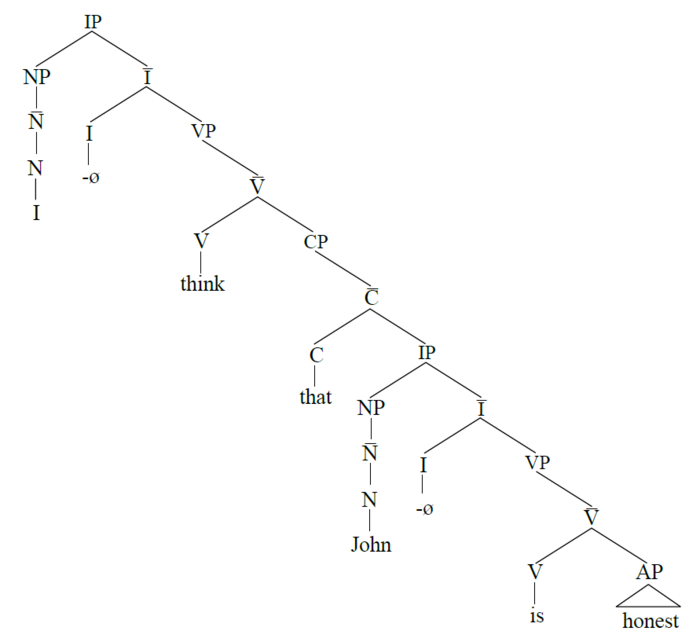
Moreover, Chomsky (1986a)

In this derivation, the I-to-C movement is an instance of
Other phrasal structures
- VP-internal subject hypothesis: A hypothesis on the inner structure of VP proposed by researchers such as Fukui and Speas (1986)[35] and Kitagawa (1986).[36] It assumes that the sentential subject is base-generated in Spec-VP, not in Spec-IP.
- DP Hypothesis: A hypothesis proposed by Abney (1987),[37] according to whom noun phrases are not NPs but DPs headed by the functional category D.
- VP shell: An analysis put forth by Larson (1988),[38] which assumes two-layered structures of VP. Later in Chomsky (1995),[26] the higher VP was replaced by vP headed by the functional category v (little/small v, traditionally written in italics).
- PredP Hypothesis: A hypothesis proposed by Bowers (1993,[39] 2001[40]), according to whom small clauses[41] are PredPs headed by the functional category Pred.
- Minimalist Program.
Hierarchical structure
The PSR has the shortcoming of being incapable of capturing sentence ambiguities.
- I saw a man with binoculars.[42]
This sentence is ambiguous between the reading I saw a man, using binoculars, in which with binoculars modifies the VP, and the reading I saw a man who had binoculars, in which the PP modifies the NP.[42] Under the PSR model, the sentence above is subject to the following two parsing rules.
- S → NP VP
- VP → V NP PP
The sentence's structure under these PSRs would be as in Figure 13.
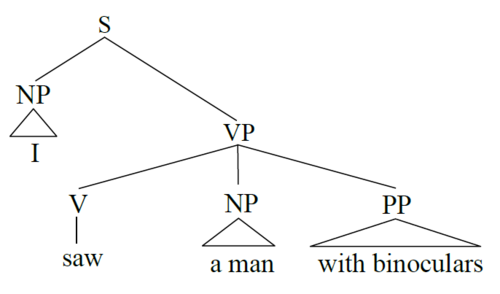
It is obvious that this structure fails to capture the NP modification reading because [PP with binoculars] modifies the VP no matter how one tries to illustrate the structure. The X-bar theory, however, successfully captures the ambiguity as demonstrated in the configurations in Figure 14 and 15 below, because it assumes hierarchical structures in accordance with the binarity principle.
Thus, the X-bar theory resolves the fourth issue mentioned in
Footnotes
- ^ Phrasal structures that lack a head.
- phrasal categoryin them is optional.
- ^ Phrasal structures that include a head.
- ^ Jackendoff (1977a)[5] assumes bar-levels up to X-triple-bar.
- ^ The functional category I was later replaced by T(ense) and Agr(eement) along the proposal by Pollock (1989).[25] The functional category Agr, however, was rejected by Chomsky (1995)[26] because it presumably made no contributions at LF. For this reason, clauses are generally assumed to be TPs headed by the functional category T in contemporary linguistic theory.
- calls this kind of tense affix movement Rule R.
- wh-wordsdo. This amounts to saying that whether is not a C0: It is subject to debate as to which syntactic category it belongs to.
- subjacency condition, and is applied in a successive cyclic manner, thus via every Spec-CP.
- ^ See Baker (1988)[34] for details.
References
- ISBN 978-0-19-967512-8.
- ^ Chomsky, Noam (1970). Remarks on Nominalization. In: R. Jacobs and P. Rosenbaum (eds.) Reading in English Transformational Grammar, 184–221. Waltham: Ginn.
- ^ Harris, Zellig (1951). Methods in Structural Linguistics. Chicago, IL: University of Chicago Press.
- ^ a b Jackendoff, Ray (1974). Introduction to the X-bar Convention. Indiana University Linguistics Club.
- ^ a b c d e Jackendoff, Ray (1977a). X-bar-Syntax: A Study of Phrase Structure. Cambridge, MA: MIT Press.
- ^ a b Jackendoff, Ray (1977b) Constraints on Phrase Structure Rules, in P. W. Culicover, T. Wasow & A. Akmajian (eds.), Formal Syntax, Academic Press, New York, pp. 249–83.
- ^ a b Chomsky, Noam (1955). The Logical Structure of Linguistic Theory. Cambridge, MA: MIT Press.
- ^ a b Chomsky, Noam (1957). Syntactic Structures. The Hague: Mouton.
- ISBN 978-3-96110-273-0.
- ^ a b c Chomsky, Noam (1965). Aspects of the Theory of Syntax. Cambridge, MA: MIT Press..
- ^ a b c d e f Haraguchi; et al. (2016). Zouhoban Chomsky Riron Jiten (Kenkyusha's Dictionary of Theoretical Linguistics Enlarged ed.). Tokyo: Kenkyusha. pp. 521–523.
- ^ Kishimoto, Hideki (2009). Basic Seisei Bunpo (The Basics of Generative Grammar). Tokyo: Hitsuji Shobo.
- ^ a b c d e f Chomsky, Noam (1981). Lectures on Government and Binding. Cambridge, MA: MIT Press.
- ^ a b Radford, Andrew (2016). Analysing English Sentences: Second Edition. Cambridge: Cambridge University Press. pp. 114–115.
- ^ Araki, Kazuo, ed. (1999). Eigogaku Yogo Jiten (A Dictionary of Technical Terms of English Linguistics). Tokyo: Sanseido. p. 587.
- ^ Araki, Kazuo, ed. (1999). Eigogaku Yogo Jiten (A Dictionary of Technical Terms of English Linguistics). Tokyo: Sanseido. p. 249.
- ^ a b c d Chomsky, Noam (1986a). Barriers. Cambridge, MA: MIT Press.
- ^ Araki, Kazuo, ed. (1999). Eigogaku Yogo Jiten (A Dictionary of Technical Terms of English Linguistics). Tokyo: Sanseido. p. 489.
- ^ "Basic English Syntax with Exercises". Retrieved 2021-10-22.
- ^ Haraguchi; et al. (2016). Zouhoban Chomsky Riron Jiten (Kenkyusha's Dictionary of Theoretical Linguistics Enlarged ed.). Tokyo: Kenkyusha. pp. 125–126.
- ^ a b Chomsky, Noam (1986b). Knowledge of Language: Its Nature, Origin and Use. New York: Praeger.
- ^ Araki, Kazuo, ed. (1999). Eigogaku Yogo Jiten (A Dictionary of Technical Terms of English Linguistics). Tokyo: Sanseido. p. 424.
- S2CID 57572491.
- ^ Chomsky, Noam (1981). The Logical Structure of Linguistic Theory. New York: Plenum Press.
- ^ Pollock, Jean-Yves (1989). "Verb Movement, Universal Grammar, and the Structure of IP". Linguistic Inquiry. 20 (3): 365–424.
- ^ a b c Chomsky, Noam (1995). The Minimalist Program. Cambridge MA: MIT Press.
- ^ Araki, Kazuo, ed. (1999). Eigogaku Yogo Jiten (A Dictionary of Technical Terms of English Linguistics). Tokyo: Sanseido. p. 16.
- ^ a b Radford, Andrew (2016). Analysing English Sentences: Second Edition. Cambridge: Cambridge University Press. pp. 86–99.
- S2CID 201091227.
- ^ Bresnan, Joan (1970). "On Complementizers: Toward a Syntactic Theory of Complement Types". Foundations of Language. 6: 297–321.
- ^ Bresnan, Joan (1972) Theory of Complementation in English Syntax, Doctoral dissertation, MIT.
- ^ Bresnan, Joan (1979). Theory of Complementation in English Syntax. New York: Garland.
- ^ Chomsky, Noam (1973). Conditions on Transformations. In: Stephen R. Anderson and Paul Kiparsky (eds.) A Festschrift for Morris Halle, 232–286. New York: Holt, Rinehart, and Winston.
- ^ Baker, Mark C. (1988). Incorporation: A Theory of Grammatical Function Changing. Chicago: University of Chicago Press.
- ^ Fukui, Naoki and Speas, Margaret J. (1986) Specifiers and Projection. MIT Working Papers in Linguistics 8: 128–172.
- ^ Kitagawa, Yoshihisa (1986). Subjects in Japanese and English, Unpublished doctoral dissertation, University of Massachusetts. Reprinted in Kitagawa (1994), Routledge.
- ^ Abney, Steven P. (1987). The English Noun Phrase in Its Sentential Aspect. Doctoral dissertation, MIT.
- ^ Larson, Richard K. (1988). On the Double Object Construction. Linguistic Inquiry 19 (3): 335–391.
- ^ Bowers, John (1993). "The Syntax of Predication". Linguistic Inquiry. 24: 591–656.
- ^ Bowers, John (2001). Predication. In: Mark Baltin and Chris Collins (eds.), The Handbook of Contemporary Syntactic Theory, 299–333, Blackwell.
- ^ Stowell, Timothy (1981). Origins of Phrase Structure. Doctoral dissertation, MIT.
- ^ a b "Syntax I". Retrieved 2021-10-23.
- ^ Chomsky, Noam (1972). Studies on Semantics in Generative Grammar. The Hague: Mouton.
See also
- Linguistics
- Natural language
- Syntax
- Constituent (linguistics)
- Parse tree
- Head (linguistics)
- Complement (linguistics)
- Phrase
- Syntactic category
- Lexical category
- Functional category
- Part of speech
- Node (linguistics)
- Generative grammar
- Universal Grammar
- Plato's problem
- Poverty of the stimulus
- Transformational grammar
- Phrase structure grammar
- Phrase structure rule
- Standard Theory
- Extended Standard Theory
- Revised Extended Standard Theory
- Government and binding theory
- C-command
- Principles-and-parameters approach
- Minimalist Program


